Correlating Discharge Current Pulse With Surface Charge Deposition in Diverse Gaseous Environment
IF 3.1
3区 工程技术
Q2 ENGINEERING, ELECTRICAL & ELECTRONIC
IEEE Transactions on Dielectrics and Electrical Insulation
Pub Date : 2025-07-22
DOI:10.1109/TDEI.2025.3591391
引用次数: 0
Abstract
The phenomenon of surface charging caused by electrical discharges has attracted significant attention because of its adverse effects on electrical systems and its industrial applications. Since the surface charging and discharge current are both influenced by the charges generated during the discharge, it is important to study the correlation quantitatively. The primary goal of the study is to analyze the relationship between the discharge current pulse and the corresponding surface charge deposition for positive and negative excitations. To establish the relation, variations were introduced in two key parameters influencing the discharge process: the discharge medium (N2, CO2, and dry air) and the pressure (100, 90, 80, 70, and 60 kPa) in each medium. The excitation voltage waveform is chosen to ensure the generation of only a single current pulse during the discharge. The positive excitation resulted in a higher pulse magnitude for N2 and dry air, whereas CO2 exhibited an opposite trend. The change in the current pulse is found to be directly proportional to the variation in charge deposition. The derived empirical formulas establish a linear correlation between the total charge computed from the current pulse and the deposited surface charge, verified by Pearson’s correlation coefficient, which suggests a good correlation strength. Of the three gaseous media, CO2 has shown a lower margin of error and consistent discharge results.不同气体环境下放电电流脉冲与表面电荷沉积的关系
放电引起的表面充电现象因其对电力系统及其工业应用的不利影响而引起了人们的广泛关注。由于表面充放电电流都受到放电过程中产生的电荷的影响,因此定量研究两者的相关性具有重要意义。本研究的主要目的是分析正负激励下放电电流脉冲与相应表面电荷沉积的关系。为了建立这一关系,我们引入了影响排出过程的两个关键参数的变化:排出介质(N2、CO2和干燥空气)和每种介质的压力(100、90、80、70和60 kPa)。激励电压波形的选择是为了保证在放电过程中只产生一个电流脉冲。正激励使N2和干燥空气的脉冲幅度增大,而CO2的脉冲幅度则相反。发现电流脉冲的变化与电荷沉积的变化成正比。导出的经验公式建立了电流脉冲计算的总电荷与沉积的表面电荷之间的线性相关关系,并通过Pearson相关系数验证了这一点,表明了良好的相关强度。在三种气体介质中,CO2显示出较低的误差范围和一致的排放结果。
本文章由计算机程序翻译,如有差异,请以英文原文为准。
求助全文
约1分钟内获得全文
求助全文
来源期刊
CiteScore
6.00
自引率
22.60%
发文量
309
审稿时长
5.2 months
期刊介绍:
Topics that are concerned with dielectric phenomena and measurements, with development and characterization of gaseous, vacuum, liquid and solid electrical insulating materials and systems; and with utilization of these materials in circuits and systems under condition of use.

 求助内容:
求助内容: 应助结果提醒方式:
应助结果提醒方式:


